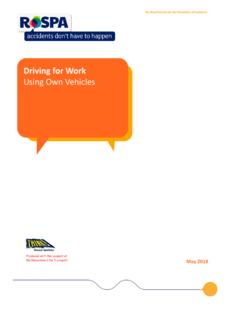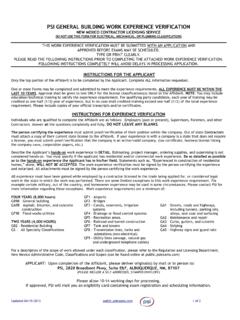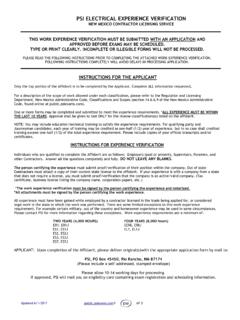Transcription of Guidance for Employers on the Control of Artificial ...
1 Health and Safety Executive1 of 8 pagesGuidance for Employers on the Control of Artificial optical radiation at work Regulations (AOR) 2010 What does this Guidance contain?Information to help you decide what you need to do to protect your workers and comply with the Regulations. Examples of safe sources of Artificial optical radiation (AOR) that require no further of hazardous sources of Artificial optical radiation that could harm workers and the types of activities where they are used. What are the Control of Artificial optical radiation at work Regulations 2010?These Regulations came into force on 27 April 2010. They require you to protect the eyes and skin of your workers from exposure to hazardous sources of Artificial optical radiation . AOR includes light emitted from all Artificial sources in all its forms such as ultraviolet, infrared and laser beams, but excludes has HSE produced this Guidance ?Some forms of Artificial light can be harmful to workers unless protective measures are in place.
2 This Guidance will help you decide whether you are already protecting your workers, or whether you need to do more. Many of you will already be taking appropriate action, so it is only those whose workers remain at risk that need to do more. 2 of 8 pagesHealth and Safety ExecutiveAOR Regulations 2010 How to use this guidanceWork through the series of questions below, referring to the accompanying notes if required. This should help you identify the things that you need to do to protect your action requiredStart hereFor more information see Note 1 For more information see Note 2 For more information see Note 3 For more information see Note 4No action requiredThis is a legal requirement and you need to take actionDo you use sources of Artificial optical radiation (AOR)?Do you use hazardous sources of AOR that could harm workers?Do you have adequate controls in place to manage the risks?Make sure you have recorded action and informed staffNo Yes Unsure3 of 8 pagesHealth and Safety ExecutiveAOR Regulations 2010 Note 1 AOR includes light emitted from all Artificial sources ie light in all its forms such as ultraviolet, infrared and laser beams, but excluding sunlight.
3 It is likely that your workers will be exposed to some form of Artificial light at work , whether from general lighting, equipment or from a work process. Note 2 The majority of light sources are safe, such as those described in List 1 below. If you only have these sources, or similar, your workers are not at risk and you don t need to do anything making this decision, it is also worth considering the following points to satisfy yourself that all workers are protected: If you have workers whose health is at particular risk, (eg those with pre-existing medical conditions made worse by light).If workers use any chemicals, (eg skin creams) which could react with light to make any health effects worse. If you have workers who are exposed to multiple sources of light at the same exposure to bright light could present unrelated risks, (eg temporary blindness could lead to mistakes being made in hazardous tasks). List 1 Safe light sourcesAll forms of ceiling-mounted lighting used in offices etc that have diffusers over bulbs or lamps.
4 All forms of task lighting including desk lamps and tungsten-halogen lamps fitted with appropriate glass filters to remove unwanted ultraviolet Computer or similar display equipment, including personal digital assistants (PDAs).Light emitting diode (LED) remote Control devices. Photographic flashlamps when used singly. Gas-fired overhead heaters. Vehicle indicator, brake, reversing and fog lamps. Any exempt or Risk Group 1 lamp or lamp system (including LEDs), as defined in British Standard BS EN 62471: Class 1 laser light product, as defined in British Standard BS EN 60825-1: 2007, for example laser printers and bar code scanners. There are also some sources of light that, if used inappropriately, eg placed extremely close to the eyes or skin, have the potential to cause harm but which are perfectly safe under normal conditions of use. Examples include:Ceiling-mounted fluorescent lighting without diffusers over bulbs or lamps. High-pressure mercury floodlighting.
5 Desktop projectors. Vehicle headlights. Non-laser medical applications such as: operating theatre and task lighting; diagnostic lighting such as foetal/neonatal transilluminators and X-ray light/viewing insect traps. Art and entertainment applications such as illumination by spotlights, effect lights and flashlamps (provided that any ultraviolet emissions have been filtered out).Multiple photographic flashlamps, for example in a studio. 4 of 8 pagesHealth and Safety ExecutiveAOR Regulations 2010 Any Risk Group 2 lamp or lamp system (including LEDs), as defined in British Standard BS EN 62471: 2008. Class 1M, 2 or 2M lasers, as defined in British Standard BS EN 60825-1: 2007, for example low-power laser above list is not exhaustive. If you have sources that are not listed but you know have not caused harm previously, and you have no reason to suspect they present a risk in the way they are used, you can assume no special Control measures are needed. Some sources of light can cause a risk of ill health, such as: burns or reddening (erythema) of the skin or surface of the eye (photokeratitis); burns to the retina of the eye; so-called blue-light damage to the eye (photoretinitis) and, damage to the lens of the eye that may bring about the early onset of cataract.
6 Examples are listed 2 Hazardous light sources Examples of hazardous sources of light that present a reasonably foreseeable risk of harming the eyes and skin of workers and where Control measures are needed include: Metal working welding (both arc and oxy-fuel) and plasma cutting. Pharmaceutical and research UV fluorescence and sterilisation systems. Hot industries furnaces. Printing UV curing of inks. Motor vehicle repairs UV curing of paints and welding. Medical and cosmetic treatments laser surgery, blue light and UV therapies, Intense Pulsed Light sources (IPLs).Industry, research and education, for example, all use of Class 3B and Class 4 lasers, as defined in British Standard BS EN 60825-1: Risk Group 3 lamp or lamp system (including LEDs), as defined in British Standard BS EN 62471: 2008, for example search lights, professional projections systems. Less common hazardous sources are associated with specialist activities for example lasers exposed during the manufacture or repair of equipment, which would otherwise not be accessible.
7 The above list is not exhaustive. If you are still unsure whether the sources you have are hazardous you could use information provided by suppliers, who have a duty under Section 6 of the Health and Safety at work etc Act 1974 to design, manufacture and supply articles for use at work that are safe, so far as is reasonably practicable, in all reasonably foreseeable circumstances of use. If a source presents a risk of harm, they should provide information and instruction on how this risk should be managed as well as making sure the articles they supply for use at work are appropriately you are still unsure whether you have hazardous sources, you may wish to refer to a trade association who may have produced sector specific Guidance and may be able to give advice. Other Standards and Guidance may also be relevant. The European Commission will publish Guidance later this year. A near final draft is at: Note 3If you use hazardous sources of light, you must put in place Control measures to reduce the risk of harm to the eyes and skin of your workers, to as low as is reasonably practicable.
8 This is the key requirement of these new of 8 pagesHealth and Safety ExecutiveAOR Regulations 2010 Some sensible measures are suggested in List 3 below and should be considered on a case-by-case basis for your particular activity. Table 1 gives examples of work activities where hazardous sources of AOR are commonplace, the industries where they are used and the Control measures considered appropriate. In order for these controls to have the best chance of success, you need to involve your workers in developing and delivering them. List 3 Control measures to consider when managing AOR risks Use an alternative, safer light source that can achieve the same result. Use filters, screens, remote viewing, curtains, safety interlocks, clamping of work pieces, dedicated rooms, remote controls and time workers in best-practice and give them appropriate information. Organise the work to reduce exposure to workers and restrict access to hazardous areas. Issue personal protective equipment, eg clothing, goggles or face shields.
9 Use relevant safety signs. Whatever measures you use, you will also need to have a system for dealing with potential over-exposures, for example, referral to a physician or occupational health provider. It is expected that using the right combination of measures in List 3 will make sure your workers are protected. The vast majority of businesses will be able to satisfy themselves at this stage that no further controls are , after this process you still suspect that workers may be at risk, a more detailed risk assessment will be required which will include calculations or measurements. This should only apply in a very small minority of cases. If you have no experience of conducting these types of assessment, seek advice from a relevant trade association or a specialist consultancy and stop the work until you are satisfied that risks have been reduced to a sufficiently low level. Note 4If you employ five or more workers, the Control measures you put in place should be recorded in a risk assessment and staff informed of them.
10 Table 1 is an example of how this could be done. Also, a template is available at: 6 of 8 pagesHealth and Safety ExecutiveAOR Regulations 2010 Table 1 work activities which use hazardous levels of Artificial optical radiation What industries use hazardous sources of intense light?What are the hazardous activities?How might workers be harmed by the intense light?What key measures do you need to consider? Metal working Welding (arc and oxyfuel)Plasma cutting Damage to eyes photokeratitis and photoconjuctivitis ( arc eye ), photochemical damage to the retina (blue light hazard) Damage to skin UV burn (erythema) Provide face shields, coveralls and gloves Protect others using screens/curtains/restricted accessProvide information and training Display appropriate warning signs Monitor and enforce use of Control measures If any workers are over-exposed, provide medical examination and consider whether follow-up health surveillance is appropriate Pharmaceuticals and research Ultraviolet sterilisation and induced fluorescenceDamage to eyes photokeratitis and photoconjuctivitis ( arc eye ), photochemical damage to the retina (blue light hazard) Damage to skin UV burn (erythema) Provide protective eyewear and make sure other areas of skin are not exposed (ie provide lab coats and gloves)



















